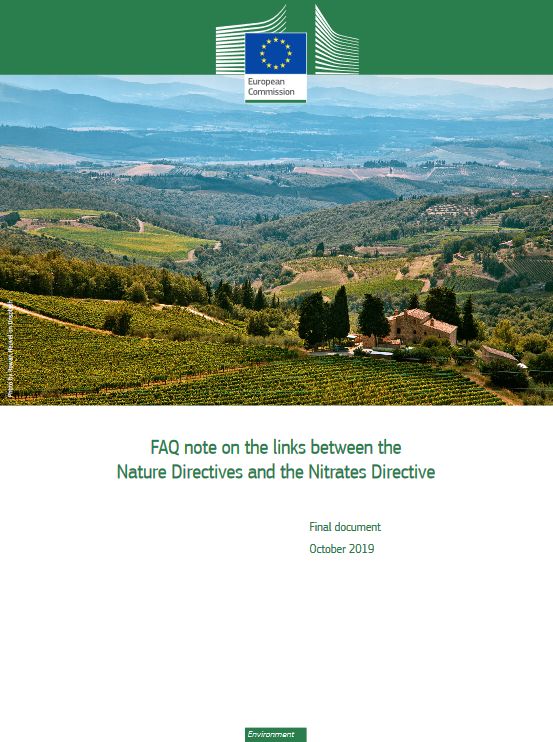Action Plan to Maintain and Restore to Favourable Conservation Status the Habitat Type 6210 Semi-natural Dry Grasslands and Scrubland Facies on Calcareous Substrates
- Publication
- Citation
Olmeda C., Šefferová V., Underwood E., Millan L., Gil T. and Naumann S. (compilers) 2019: EU Action plan to maintain and restore to favourable conservation status the habitat type 6210 Semi-natural dry grasslands and scrubland facies on calcareous substrates (Festuco-Brometalia) (*important orchid sites). European Commission Technical Report.
- Language
-
English
- Authorship
-
Sandra NaumannConcha Olmeda (The N2K Group / ATECMA)Viera Šefferová (The N2K Group / Daphne Institute of Applied Ecology)Evelyn Underwood (Institute of European Environmental Policy)Lucía Millan (The N2K Group / ATECMA)Teresa Gil (The N2K Group / ATECMA)
- Credits
Contributors: Alfonso San Miguel (Politécnica University of Madrid, Spain), Anamaria Roman (Institute of Biological Research Cluj, Romania), Andraž Čarni (Slovenian Academy of Sciences), Andy Bleasdale (National Parks and Wildlife Service, Ireland), Axel Ssymank (Federal Agency for Nature Conservation, BfN), Brendan Dunford (Burren Programme, Ireland), Cliona O’Brien (National Parks and Wildlife Service, Ireland), Daniela Gigante (University of Perugia, Italy), Douglas Evans (European Topic Centre for Biodiversity, European Environment Agency), Gergely Király University of West Hungary), Gwyn Jones (European Forum on Nature Conservation and Pastoralism), Helena Lager (Swedish Environmental Protection Agency), Hrvoje Kutnjak (University of Zagreb, Croatia), Ivana Jongepierová (Nature Conservation Agency, Czech Republic), Iveta Škodová (Slovak Academy of Sciences), James R. Martin (Botanical, Environmental & Conservation (BEC) Consultants Ltd, Ireland), Ján Šeffer (Daphne Institute of Applied Ecology), Jasenka Topić (University of Zagreb, Croatia), Joost Dewyspelaere (BirdLife International), Jørgen Lissner (Danish Environmental Protection Agency), Jürgen Dengler (Eurasian Dry Grassland Group, University of Bayreuth), Louis-Marie Delescaille (Nature and Forest Department, Belgium), Maria Long (National Parks and Wildlife Service, Ireland), Meeli Mesipuu (Estonian Seminatural Communities Conservation Association), Mihail Mihailov (Ministry of Environment, Bulgaria), Mike Edwards (BWARS, UK), Pawel Pawlaczyk (Naturalists Club, Poland), Richard Jefferson (Natural England, UK), Robert Paxton (Martin Luther University Halle-Wittenberg, Germany), Sam Ellis (Butterfly Conservation Europe), Solvita Rūsiņa (University of Latvia), Sue Collins (Butterfly Conservation Europe), Tamara Kirin (Croatian Agency for Environment and Nature), Thorsten Englisch (University of Vienna), Urs Jäger (State Office for Environmental Protection - Saxony-Anhalt, Germany), Valerijus Rasomavicius (Institute of Botany, Nature Research Centre, Lithuania).
- Funding
-
European Commission, Directorate-General Environment (DG Environment), International - Published by
-
European Commission, Directorate-General Environment (DG Environment), International - Year
- Dimension
- 123 pp.
- Project
- Project ID
- Table of contents
-
Click to show full table of contents
SUMMARY
FRAMEWORK FOR ACTION
1. INTRODUCTION AND BACKGROUND
1.1 Action plan geographical scope
2. DEFINITION, DESCRIPTION AND ECOLOGICAL CHARACTERIZATION
2.1. Habitat definition and description
2.1.1 Priority habitat identification
2.1.2 Dynamic stages of succession
2.1.3 Differences across countries and regions. Interpretation problems
2.1.4 Conclusions and recommendations
2.2 Ecological requirements
2.2.1 Soil (including water and nutrients availability)
2.2.2 Topography
2.2.3 Climate
2.3 Related habitats
2.4 Related species
Mammals
2.5 Ecosystem services and benefits
2.6 Geographic distribution
2.6.1. Trend of surface area
2.6.2 Distribution of the habitat 6210 in Natura 2000
3. CONSERVATION STATUS, THREATS AND PRESSURES
3.1 Conservation status and trends
3.1.1 Conservation status at biogeographical region level
3.1.2 Conservation Status of the habitat at Member state level in each biogeographical region
3.1.3 Trend in conservation status of the habitat 6210
3.2 Conservation status of the habitat in Natura 2000 sites
3.3 Methodologies for conservation status assessment and monitoring
3.3.1 Reference sites for the habitat type in Favourable Conservation Status
3.3.2 Favourable Reference Values
3.3.4 Conclusions and recommendations
3.4 Threats and pressures
3.4.1 Main threats and pressures identified for the habitat
3.4.2 Identification of areas where action is urgent to combat high impacts
3.4.3 Procedures and methodologies to determine and assess the main threats and pressures to the habitat
3.4.4 Conclusions and recommendations
3.5 Climate change effects
3.5.1 Evidence of climate change effects on 6210 habitat
3.5.2 Habitat vulnerability to climate change and its adaptation capacity
3.5.3 Conclusions and recommendations
4. HABITAT CONSERVATION AND MANAGEMENT OBJECTIVES
4.1 Background and context
4.2 Overall objective of this action plan
4.3 Setting objectives at biogeographical and country level
4.3.1 Targets and quantitative values for conservation objectives
4.4 Setting conservation objectives at site level
5. CONSERVATION AND RESTORATION MEASURES
5.1 Key management practices for maintenance of the habitat in good condition
5.1.1 Grazing
5.1.2 Mowing
5.1.3 Management for wildlife
5.1.4 Managing conflicts of interest
5.2 Grassland restoration
5.2.1 Managing scrub
5.2.2 Control of weed and invasive species
5.3 Grassland re-creation
5.3.1 Habitat management and monitoring after recreation
5.4 Planning for conservation management in a specific area
5.5 Criteria to prioritise measures and to identify priority areas for action
5.7 Main stakeholders to define and implement the measures
5.8 Challenges, difficulties and possible solutions
5.9 Conclusions and recommendations
6. KNOWLEDGE AND MONITORING
6.1 Habitat monitoring methods
6.2 Criteria to select monitoring sites/localities
6.3 Conclusions and recommendations
6.4 Monitoring effectiveness of the action plan and conservation measures
6.5 Review of the action plan
7. COSTS, FUNDING AND SUPPORTING TOOLS
7.1 Cost of conservation measures
7.1.1 Cost assessment
7.2 Potential sources of financing
7.2.1 Common Agricultural Policy funding
7.2.2 LIFE projects
7.2.3 European Regional Development Fund and other EU funds
7.2.4 Other approaches and support tools for grazing and shepherding
7.3 Main funding gaps and difficulties
7.4 Conclusions and recommendations
ANNEX
1. Habitat definition
1.1 Definition according to the Interpretation Manual of European Union Habitats
1.2 Habitat definition according to the EUNIS
1.3 Habitat definition based on the European checklist of vegetation
2. Description of related habitats
3. Recent LIFE projects targeted to conservation of dry grasslands - Keywords
-
Birds and Habitats Directives, Nature Directives, Nitrates Directive, Invasive Alien Species Regulation, Nature Plan, EU28, Natura 2000, governance, Habitat Action PlansGermany, Slovenia, Lithuania, Europe





